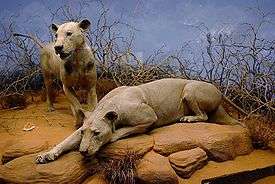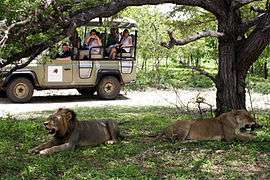Masai lion
| Masai lion[1] | |
|---|---|
.jpg) | |
| Male Masai lion at Ngorongoro, Tanzania | |
 | |
| Masai lioness at Samburu, Kenya | |
| Scientific classification | |
| Kingdom: | Animalia |
| Phylum: | Chordata |
| Class: | Mammalia |
| Order: | Carnivora |
| Family: | Felidae |
| Genus: | Panthera |
| Species: | P. leo |
| Subspecies: | P. l. nubica |
| Trinomial name | |
| Panthera leo nubica (Blainville, 1843) | |
The Masai lion or East African lion (Panthera leo nubica syn. Panthera leo massaica) is a lion subspecies that is found in eastern Africa. The type specimen is described as being from "Nubia". The subspecies includes previously recognized subspecies like massaica, which was initially described from the Tanganyika Territory in Eastern Africa.[2][3]
Physical characteristics





Neumann first described the Masai lion as being less cobby with longer legs and less curved backs than other lion subspecies. Males have moderate tufts of hair on the knee joint, and their manes are not full but look like combed backwards.[4]
Male East African lions are generally 2.5–3.0 metres (8.2–9.8 feet) long including the tail. Lionesses are generally smaller, at only 2.3–2.6 metres (7.5–8.5 feet). Lions, male or female, have a shoulder height of 0.9–1.10 metres (3.0–3.6 feet). In weight, males are generally 145–205 kg (320–452 pounds), and females are 100–165 kg (220–364 pounds).
A male near Mount Kenya weighed 272 kg (600 pounds) (Nowell and Jackson, 1996). This would make it heavier than the current, average Southeast African lion in Kruger National Park, South Africa,[3][5] but not the heaviest Transvaal lion ever recorded.[6]
Male Masai lions are known for a great range of mane types. Mane development is related to age: older males have more extensive manes than younger ones; manes continue to grow up to the age of four to five years, long after lions have become sexually mature. Males living in the highlands above 800 m (2,600 ft) altitude develop heavier manes than lions in the more humid and warmer lowlands of eastern and northern Kenya. They have scanty manes or are even completely maneless.[7]
Distribution and habitat
Masai lions were first described on the basis of observations in northern Uganda, near Kavirondo and in southern Kenya, as well as near Lake Manyara, around Mount Kilimanjaro and in the Tanga Region.[4]
Taxonomic history
The German zoologist Neumann observed lions in Eastern Africa, and proposed the trinomen Felis leo massaica in 1900 based on morphological differences compared with lions from Somalia. His type specimens consist of one male killed near Kibaya, and one female killed at the Gurui River.[4] A decade later, the Swedish zoologist Lönnberg described two lion specimen from the environs of Mount Kilimanjaro under the name of Felis leo sabakiensis that were killed during a Swedish zoological expedition to East Africa.[8] In 1914, the American zoologist Heller described the Abyssinian lion under the name Felis leo roosevelti on the basis of a male lion presented to United States' President Theodore Roosevelt, allegedly from the vicinity of Addis Abeba.[9] In 1939, the American zoologist Allen recognized the trinomen Felis leo massaica as valid, and subordinated F. l. sabakiensis and F. l. roosevelti to this subspecies.[2]
Pocock subordinated lions to the genus Panthera in 1930, when he wrote about Asian lions.[10] Ellerman and Morrison-Scott recognized just two lion subspecies, namely the Asiatic P. l. persica and the African P. l. leo, known as the Barbary lion at the time.[11] Various authors recognized between seven and 10 African lion subspecies.[12] Until 2005, some authors considered P. l. massaica as a valid taxon;[1] some considered it synonymous with P. l. nubica described by Blainville in 1843 from Nubia.[3] Others followed the classification proposed by Ellerman and Morrison-Scott, recognizing two subspecies.[13] Some results of genetic analysis seem to corroborate this assessment.[14][15][16]
Conservation
This lion subspecies is relatively common and well protected in large protected areas as the Serengeti-Mara ecosystem.
In captivity
In 2006, eight captive individuals were registered under the name P. l. massaicus from Uganda and Kenya, and 23 as P. l. nubicus from Tanzania by the International Species Information System.[17]
Gallery
 Male lion in the Serengeti
Male lion in the Serengeti Young male lion in the Serengeti
Young male lion in the Serengeti Lions mating at Masai Mara
Lions mating at Masai Mara Lion pair at Selous Game Reserve
Lion pair at Selous Game Reserve
See also
References
- 1 2 Wozencraft, W.C. (2005). "Order Carnivora". In Wilson, D.E.; Reeder, D.M. Mammal Species of the World: A Taxonomic and Geographic Reference (3rd ed.). Johns Hopkins University Press. pp. 532–628. ISBN 978-0-8018-8221-0. OCLC 62265494.
- 1 2 Allen, G. M. (1939). A Checklist of African Mammals. Bulletin of the Museum of Comparative Zoology at Harvard College 83: 1–763.
- 1 2 3 Haas, S. K., Hayssen, V., Krausman, P. R. (2005). Panthera leo. Mammalian Species (762): 1–11.
- 1 2 3 Neumann, O. (1900). Die von mir in den Jahren 1892–95 in Ost- und Central-Afrika, speciell in den Massai-Ländern und den Ländern am Victoria Nyansa gesammelten und beobachteten Säugethiere. Zoologische Jahrbücher. Abtheilung für Systematik, Geographie und Biologie der Thiere 13 (VI): 529–562.
- ↑ Smuts, G.L.; Robinson, G.A.; Whyte, I.J. (1980). "Comparative growth of wild male and female lions (Panthera leo)". Journal of Zoology. 190 (3): 365–373. doi:10.1111/j.1469-7998.1980.tb01433.x.
- ↑ Wood, The Guinness Book of Animal Facts and Feats. Sterling Pub Co Inc. (1983), ISBN 978-0-85112-235-9
- ↑ Gnoske, T. P., Celesia, G. G., Kerbis Peterhans, J. C. (2006). Dissociation between mane development and sexual maturity in lions (Panthera leo): solution to the Tsavo riddle?. Journal of Zoology 270(4): 551–560. Abstract
- ↑ Lönnberg, E. (1910). Mammals. In: Sjöstedt, Y. (ed.) Wissenschaftliche Ergebnisse der Schwedischen Zoologischen Expedition nach dem Kilimandjaro, dem Meru und den umgebenden Massaisteppen Deutsch-Ostafrikas 1905-1906. Volume 1. Königlich schwedische Akademie der Wissenschaften, Uppsala.
- ↑ Heller, E. 1914. New races of carnivores and baboons from equatorial Africa and Abyssinia. Smithsonian Miscellaneous Collections 61(19): 1–12.
- ↑ Pocock, R. I. (1930). The lions of Asia. Journal of the Bombay Natural Historical Society 34: 638–665.
- ↑ Ellerman, J. R., and T. C. S. Morrison-Scott. (1966). Checklist of Palaearctic and Indian Mammals 1758 to 1946. Second edition. British Museum (Natural History), London.
- ↑ Hemmer, H. (1974). Untersuchungen zur Stammesgeschichte der Pantherkatzen (Pantherinae). III. Zur Artgeschichte des Löwen Panthera (Panthera) leo (Linnaeus 1758). Veröffentlichungen der Zoologischen Staatssammlung München, 17: 167–280.
- ↑ Meester, J., Setzer, H. W. (1977). The mammals of Africa. An identification manual. Smithsonian Institution Press, Washington, DC.
- ↑ O’Brien, S. J.; Martenson, J. S.; Packer, C.; Herbst, L.; de Vos, V.; Joslin, P.; Ott-Joslin, J.; Wildt, D. E. & Bush, M. (1987). "Biochemical genetic variation in geographic isolates of African and Asiatic lions" (PDF). National Geographic Research. 3 (1): 114–124.
- ↑ Dubach, J., Patterson, B. D., Briggs, M. B., Venzke, K., Flamand, J., Stander, P., Scheepers, L. and Kays, R. W. (2005). Molecular genetic variation across the southern and eastern geographic ranges of the African lion, Panthera leo. Conservation Genetics 6(1): 15.
- ↑ Bauer, H.; Nowell, K. Packer, C. (2012). "Panthera leo". IUCN Red List of Threatened Species. Version 2013.2. International Union for Conservation of Nature.
- ↑ Barnett, R., Yamaguchi, N., Barnes, I., Cooper, A. (2006). The origin, current diversity and future conservation of the modern lion (Panthera leo). Proceedings of the Royal Society B 273 (1598): 2119–2125. doi:10.1098/rspb.2006.3555 PMID 16901830
External links
 Media related to Panthera leo nubica at Wikimedia Commons
Media related to Panthera leo nubica at Wikimedia Commons